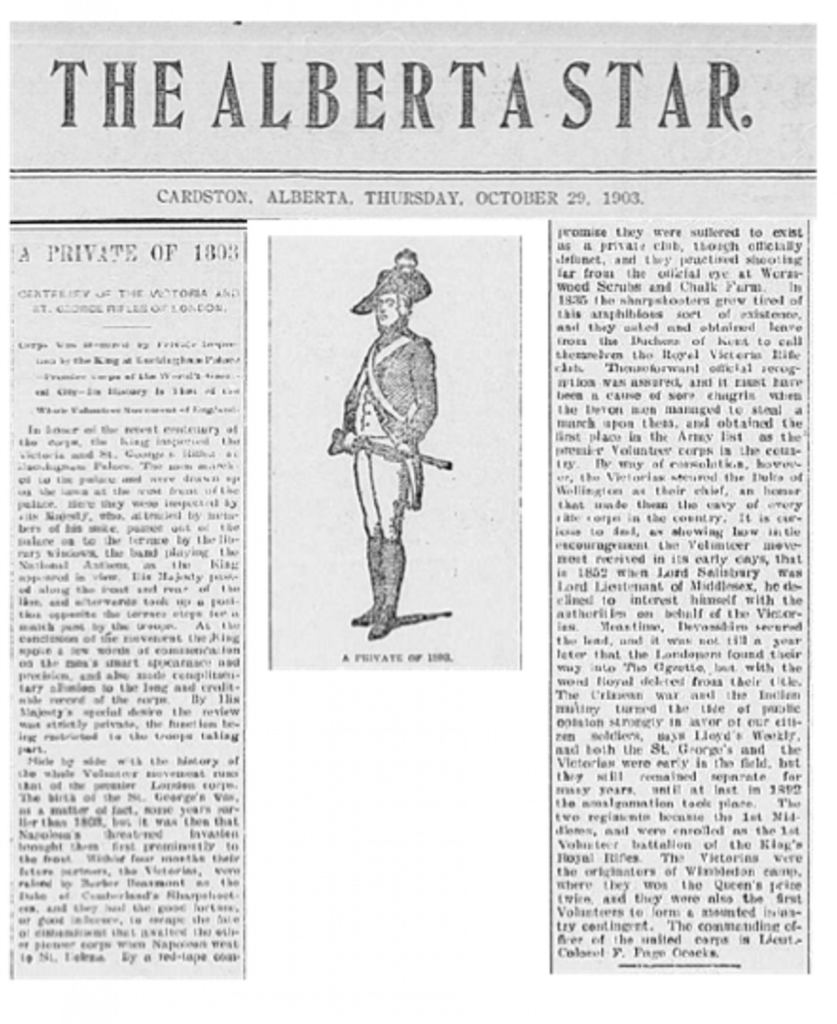
(with links to relevant parts of this site)
Centenary of the Victoria & St george’s Rifles of London, the Alberta Star – 29 October 1903
In honor of the recent centenary of the Corps, the King inspected the Victoria and St George’s Rifles at Buckingham Palace. The men marched to the Palace and were drawn up on the lawn at the west front of the Palace. Here they were inspected by his Majesty, who, attended by members of his suite, passed out of the palace on to the lawn by the library windows, the band playing the National Anthem, as the King appeared in view. His Majesty passed along the front and rear of the line, and afterwards took up a position opposite the terrace steps for the match past by the troops. At the conclusion of the movement the King spoke a few words of commendation on the men’s smart appearance and precision, and also made complimentary allusion to the long and creditable record of the Corps. By His Majesty’s special desire the review was strictly private, the function being restricted to the troops taking part.
Side by side with the history of the whole Volunteer movement runs that of the premier London corps. The birth of the St George’s was, as a matter of fact, some years earlier than 1803, but it was then that Napoleon’s threatened invasion brought them first prominently to the front. Within four months their future partners, the Victoria’s, were raised by Barber Beaumont as the Duke of Cumberland’s Sharpshooters, and they had the good fortune, or good Influence, to escape the fate of disbandment that awaited the other pioneer corps when Napoleon went to St. Helena. By a red-tape compromise they were suffered to exist as a private club, though officially defunct, and they practised shooting far from the critical eye at Wormwood Scrubs and Chalk Farm.
In 1835 the Sharpshooters grew tired of this amphibious sort of existence, and they asked and obtained leave from the Duchess of Kent to call themselves the Royal Victoria Rifle Club. Thence forward official recognition was assured, and it must have been it cause of sore chagrin when the Devon men managed to steal a march upon them, and obtained the first place in the Army list as the premier Volunteer corps in the country. By way of consolation, however, the Victoria’s secured the Duke of Wellington as their chief, in honor that made them the envy of every other corps in the country. It is curious to find, as showing how little encouragement the Volunteer movement received in its early days, that in 1852 when Lord Salisbury was Lord Lieutenant of Middlesex, he declined to interest himself with the authorities on behalf of the Victoria’s. Meantime, Devonshires secured the lead, und it was not till a year later that the Londoners found their way into The Gazette, but with the word Royal deleted from their title.
The Crimean war and the Indian mutiny turned the tide of public opinion strongly in favor of our citizen soldiers, says Lloyd’s Weekly, and both the St George’s and the Victoria’s were early in the field, but they still remained separate for many years, until at last in 1892 the amalgamation took place. The two regiments became the 1st Middlesex, and were enrolled as the 1st Volunteer battalion of the King’s Royal Rifles. The Victoria’s were the originators of Wimbledon camp, when, they won the Queen’s prize twice, and they wore also the first Volunteers to form a mounted infantry contingent.
The commanding officer of the united corps is Lieut Colonel F Page Ococks.